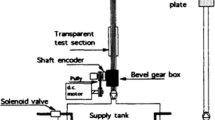Abstract
For horizontal directional drilling crossing project, pumping pressure is a key factor that influences the drilling efficiency and the stability of borehole wall. There are nevertheless many theoretical difficulties in calculating and analyzing the dynamic law of pumping pressure. This paper aims to resolve these problems based on construction features and rheological theory. The power-law fluid model is adopted to describe rheological properties of drilling fluid. In order to prevent blowout from occurring in the drilling process, the maximum allowable mud pressure at different reaming stages is calculated by numerical method under condition of complicated geological structure. The borehole pressure must be greater than minimum required mud pressure which is achieved by hydrodynamic calculation method, only meet this condition can it transport the cuttings to the ground surface. Moreover, the pressure loss in the drill string, including loss in drill rod and loss through bit nozzles, is also calculated by newly derived equations. Finally, combining with practical engineering field data, the appropriate range of pumping pressure at different reaming stages is obtained through the calculation results of three types of pressure, which can help engineers minimize the occurrence of accidents and enhance the drilling efficiency.










Similar content being viewed by others
References
Ariaratnam ST, Stauber RM, Bell J, Harbin B, Canon F (2003) Predicting and controlling hydraulic fracturing during horizontal directional drilling. Proceedings of the ASCE International Conference on Pipeline Engineering and Construction 2: 1334–1345
Ariaratnam ST, Harbin BC, Stauber RL (2007) Modeling of annular fluid pressures in horizontal boring. Tunn Undergr Space Technol 22:610–619
Baumert ME, Allouche EN, Moore ID (2004) Experimental investigation of pull loads and borehole pressures during horizontal directional drilling installations. Can Geotech J 41:672–685
Baumert ME, Allouche EN, Moore ID (2005) Drilling fluid considerations in design of engineered horizontal directional drilling installations. Int J Geomech 5:339–349
Bourgoyne AT, Milheim KK, Chenevert ME, Young FS (1991) Applied drilling engineering, Society of Petroleum Engineers, Richardson
Cai LX, He LM, Lv YL, Xue ZX (2011) Hole-bottom slurry mechanical properties of horizontal directional drilling in pipeline crossing project. Oil Gas Stg Trans 30:25–29
Ding P, Yan XZ, Yang XJ (2007) The mechanical parameter research of horizontal directional drilling crossing project. J SWPU 29:152–155
Duyvestyn G, Knight M (2005) Soil deformations due to horizontal directional drilling pipeline installation. Trenchless Technol 22:1–6
Lueke JS, Ariaratnam ST (2005) Surface heave mechanisms in horizontal directional drilling. J Constr Eng Manag 131:540–547
Ma BS (2008) The science of trenchless engineering. China Communications Press, Beijing, pp 483–581
Ma BS, Najafi M, Shen H, Wu L (2010) Risk evaluation for maxi horizontal directional drilling crossing projects. J Pipeline Syst Eng 1:91–97
Shu B, Ma BS (2016) The return of drilling fluid in large diameter horizontal directional drilling boreholes. Tunn Undergr Space Technol 52:1–11
Shu B, Ma BS, Lan H (2014) Cuttings transport mechanism in a large-diameter HDD borehole. J Pipeline Syst Eng 6:04014017
Slavin LM (2010) Parametric dependency and trends of HDD pull loads. J Pipeline Syst Eng 1:69–76
Slavin LM, Najafi M (2012) Effect of pipe stiffness on maxi-HDD pull loads. J Pipeline Syst Eng 3:22–31
Van Brussell GG, Hergarden HJAM (1997) Installation of pipelines beneath levees using horizontal directional drilling. Delft Geotechnics, Delft, pp 1–16
Wang X, Sterling RL (2007) Stability analysis of a borehole wall during horizontal directional drilling. Tunn Undergr Space Technol 22:620–632
Yan XF, Ma BS, Zeng C, Liu Y (2016) Analysis of formation fracturing for the Maxi-HDD Qin River crossing project in China. Tunn Undergr Space Technol 53:1–12
Acknowledgements
The authors acknowledge the anonymous reviewers and the editor for their valuable comments and suggestions. This study was funded by the Open Foundation from Key Laboratory of Ministry of Education for Efficient Mining and Safety of Metal Mines, USTB (ustbmslab201706); the Handan City Science and Technology Project (1721211050-4).
Author information
Authors and Affiliations
Corresponding author
Rights and permissions
About this article
Cite this article
Su, H., Ma, H., Hu, B. et al. An analysis of drilling fluid pumping pressure for the Maxi-HDD crossing project. Arab J Geosci 11, 347 (2018). https://doi.org/10.1007/s12517-018-3708-y
Received:
Accepted:
Published:
DOI: https://doi.org/10.1007/s12517-018-3708-y



